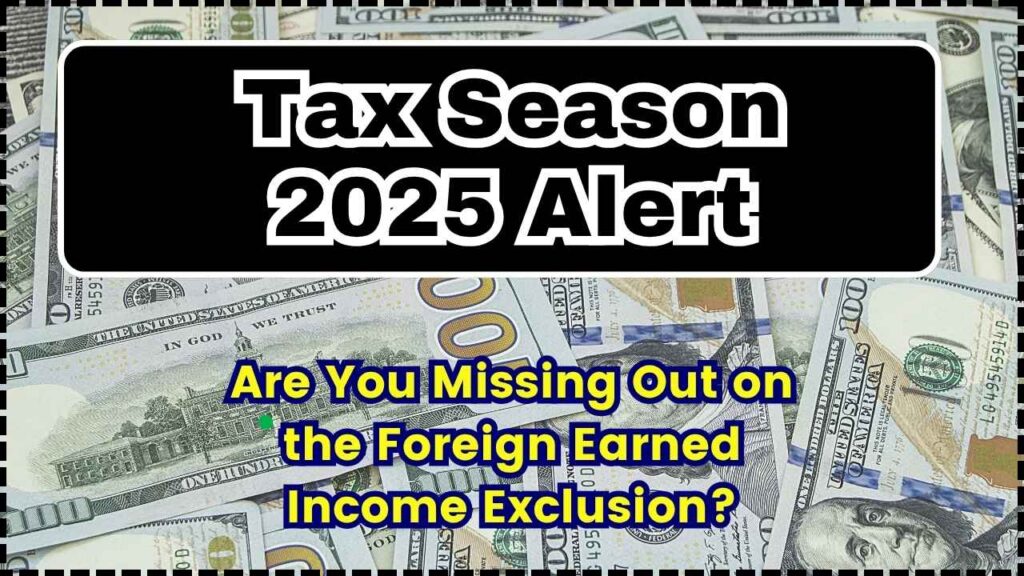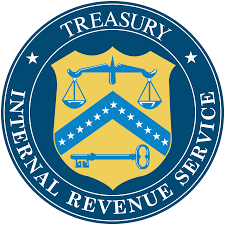
Tax Season 2025 Alert: Foreign Earned Income Exclusion (“FEIE”)—for tax year 2025 (filing in 2026), this benefit just got more powerful. Let me walk you through it from start to finish. For 2025, the IRS raised the FEIE limit from $126,500 to $130,000 per person. If a married couple both qualify, that exclusion doubles to $260,000. Plus, the Foreign Housing Exclusion can wipe out even more of your taxable income—but only if you file Form 2555, otherwise the IRS won’t give it to you. If you’re finishing your qualifying 330 days abroad a bit late, Form 2350 gives you extra time to qualify.
Tax Season 2025 Alert
For 2025, the Foreign Earned Income Exclusion lets U.S. citizens abroad exclude up to $130,000 (for a couple, $260,000) from their U.S. taxable income, plus a generous housing exclusion. To reap the benefits, you must:
- Establish tax home abroad
- Track qualifying days
- Calculate housing correctly
- File Forms 2555, plus 2350/673 if needed
- Pair with Foreign Tax Credit when appropriate
With careful planning, detailed records, and correct filing, your tax season becomes smoother and more lucrative. It’s a legally solid and effective strategy that smart expats—and tax pros—should use.
| Highlight | Details |
|---|---|
| FEIE Limit (2025) | $130,000 per person; $260,000 for married couples when both qualify. |
| Housing Exclusion | Base amount: $20,800 (16%); Cap: $39,000 (30%), with higher caps in some high-cost cities. |
| Qualifying Tests | Physical Presence: 330 full 24‑hour days abroad; Bona Fide Residence: set one calendar year overseas with intent to stay. |
| Required Forms | File Form 2555 with your Form 1040; file Form 2350 if you’ll qualify after deadline; optionally file Form 673 with your employer. |
| Timing Info | April 15, 2026 is regular deadline; expats automatically get until June 15—interest starts April 16. |
| Credits and Stacking | Use Foreign Tax Credit (Form 1116) alongside FEIE for full savings; be mindful of credit use for earned‑income based tax benefits. |
| Official IRS Source | Foreign Earned Income Exclusion |
| High-Cost Localities | Check Notice 2025‑16 for city‑specific housing limits. |
Why the FEIE Matters (and Why You Should Care)?
The U.S. taxes its citizens on income from anywhere in the world. But if your “tax home” is in a foreign country and you earn active income (like wages or self-employment earnings) abroad, the FEIE avoids double taxation and keeps more of your money where it belongs: in your hands.
Example: You’re an engineer in Berlin, Tokyo, or Dakar—without FEIE, all your wages get taxed in both countries. With FEIE, you can exclude up to $130,000 for 2025—massive savings. On top of that, if your rent or utilities are expensive, a Foreign Housing Exclusion further reduces taxable income.
Deep Dive: How It Works
Qualifying as an Expat
To claim FEIE, you must:
- Have a tax home in a foreign country: This means your main place of work and life is not the U.S.
- Earn foreign income: Only wages, bonuses, self-employed earnings; not interest, dividends, pensions, or passive income.
- Pass one of two tests:
- Physical Presence Test: 330 full 24-hour days abroad in a consecutive 12-month period.
- Bona Fide Residence Test: Be a legal resident of a foreign country for a full calendar year, with no indefinite intent to return.
Calculating Your Exclusion
- Full-year: If you meet the full test, exclude the entire $130,000.
- Partial-year: If you qualify only part of the year, multiply $130,000 by (number of qualifying days ÷ 365).
Housing Exclusion at a Glance
- Base Amount: $20,800 annually (16% of $130,000).
- Cap: $39,000 (30% of $130,000). Check monthly limitations for high-cost areas via IRS Notice 2025-16.
- Allowable Costs:
- Rent payments
- Utilities (if not included in rent)
- Insurance, parking, non-luxury furniture rentals
Disallowed expenses: mortgage, property taxes, repairs, or remodels.
Step-by-Step Process: Tax Season 2025 Alert
Step 1: Establish Eligibility
- Log entry and exit dates to prove your physical presence.
- Gather pay statements and activity logs.
Step 2: Determine Baseline Housing Exclusion
- Subtract $20,800 from your total housing expense.
- Cap the result at $39,000 or local cap.
Step 3: File Forms
- Form 2555: reports exclusion, days qualifying, housing costs.
- Form 2350: if you expect to hit 330 days after April 15.
- Form 673 (optional): tells your employer to stop U.S. tax withholding.
Step 4: Claim Foreign Tax Credit
- If you’ve excluded max FEIE but still paid local taxes, file Form 1116.
- Use credits to reduce U.S. tax liability even further.
Common Pitfalls & How to Avoid Them
- Miscounting Days: Only count full 24-hour periods—partial days don’t count.
- Wrong Housing Amounts: Double-check what counts. Don’t include furnishings, mortgage, or luxury services.
- Missing Deadlines: April 15 for those in the U.S.; June 15 for qualifying expats—interest starts after April 15. File 2350 if needed.
- Revocation Lockdown: If you revoke FEIE, you can’t claim it again for five years without IRS approval.
- Credit Collision: Don’t exclude all income if you need earned income to claim tax credits like the child tax credit or earned income credit.
Timeline Checklist
| By When | Action |
|---|---|
| January–July | Track your foreign travel days closely. |
| End of Year | Total up your actual foreign-earned income and housing costs. |
| Jan–Mar 2026 | Prepare IRS Forms 2555 and 1116; check need for Form 2350 or 673. |
| April 15, 2026 | U.S. return due if in the States. Expat extension until June 15. |
| April 15–Mid Jun | File 2350 before deadline; interest starts accruing from April 15. |
| June 15, 2026 | Expat deadline. Any tax due plus interest must be paid by now. |
| September 2026 | If filing late, IRS charges interest and penalties—avoid this! |
Real-World Example 2: Sarah in Singapore
- Income: $95,000 as a software developer.
- Days in Singapore: 340 (qualifies for full FEIE).
- Rent + utilities: $25,000.
- Social insurance employer cost: $2,000 (included).
- Calculation:
- FEIE: $95,000 (below $130K cap).
- Housing Exclusion: ($25,000 – $20,800) = $4,200.
- Excluded total: $99,200.
- Foreign Tax Credit: Used for Singapore income tax paid
Advanced Pro Tips

- Balance FEIE & Foreign Tax Credit: Over $130K common? Use FEIE up to cap, switch to credit after.
- High-Cost City Breakdowns: Cities like London, Oslo, Sydney affect monthly caps. Always check IRS Notice 2025-16.
- Self-Employed Strategy: Pay self-employment tax, but earnings still exclude under FEIE. Consider corporate structure or LLC elections for tax efficiency.
- Married Couples Filing Separately: If one spouse doesn’t qualify, they may owe more tax. Consider filing jointly if possible.
- Audit Defense: Keep thorough documentation—airline tickets, lease, pay statements. IRS picks random FEIE returns for checks.
Tax Refunds Are Hitting Bank Accounts This Week—Are You on the IRS Payment List?
Proposed $40,000 SALT Cap: Who Stands to Gain the Most From This Major Tax Break?
$2,500 Stimulus Checks Coming Soon; Who Qualifies and When to Expect Your Payment
FAQs
Q: Do I owe U.S. tax if I live in the U.K. and earn £90,000?
A: You likely qualify for FEIE. Convert to U.S. dollars (e.g., $120,000), exclude it, and still file for credits if U.K. tax applies.
Q: What if my employer pays for free lodging?
A: Employer-provided lodging counts as income. You can’t exclude that cost again under housing exclusion—no double dipping.
Q: Can I claim FEIE and then stop withholding?
A: Yes. File Form 673 so your U.S. employer knows not to withhold federal tax.
Q: What if I need more time to meet 330 days?
A: File Form 2350 by April 15 (or June 15 if abroad). Interest applies, but you avoid penalties.
Q: Will revoking FEIE affect future planning?
A: Yes—it locks you out for five years unless the IRS waives that. Make it a permanent decision.











